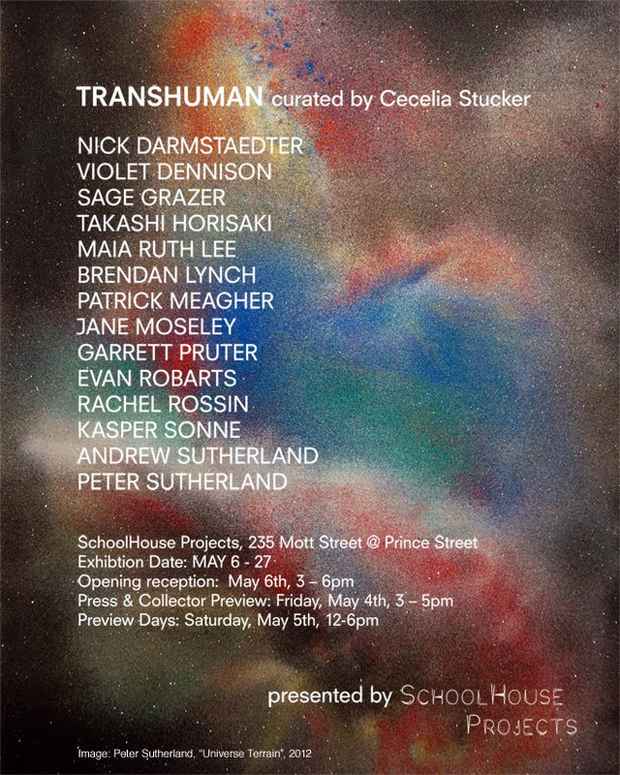"SchoolHouse Projects" Exhibition
The Old School

This event has ended.
SchoolHouse Projects pulls from support shown to its art fair precursor, SPRING/BREAK Art Show, and furthers a commitment to showcasing innovative curatorial voices within nontraditional spaces.
“We were so engaged by the reaction to our little alternative art fair in March,” says SchoolHouse co-organizer and SPRING/BREAK co-director Ambre Kelly. “We realized there’s a need within the art community. Important work is being seen not nearly as much as it is being made. And the essential voice of the curator is often being overlooked.”
To be housed within a portion of Old School – a multi-purpose schoolhouse space on Mott Street – SchoolHouse Projects shares its curator focus with that of SPRING/BREAK Art Show, along with its location within the four-story historic Nolita landmark. Rather than span the entire building, “something which is reserved for much larger endeavors…you know, like fairs,” says SchoolHouse co-organizer Andrew Gori, the project space occupies an adjacent structure connecting to the building’s back recess courtyard.2
To curate the break-out exhibition, Cecelia Stucker has been engaged by SchoolHouse Projects to feature essential work by fourteen emerging artists. “Curating is a dialog,” says Stucker, engaging a process-oriented method for selecting work from each of the fourteen artists in SchoolHouse Projects inaugural exhibition. “And I, like many of my peers and our predecessors, have been engaged in a conversation dealing with the struggle to define the meaning of life. We live, work, and play in one of the most stimulating but toughest cities. Taking a step back, asking the bigger questions – where it leads, what it’s worth, why – is an inescapable part of our lives. I’ve posited a series of ideas on the subject to artists whose considerations I value and trust. The result of our dialog will be reflected in the pieces presented in Transhuman.”
Stucker, living temporarily in Los Angeles, has assembled the artists and developed the exhibition via email, skype and telephone. Transhuman will expose this atypical off-site curatorial process by displaying her correspondences with participating artists as the conceptual platform linking their works. Each consider ideological meaning in everyday life through the divergent lenses of numerous “isms”, including Materialism, Instinctivist, Humanism, Existentialism, Escapism, Hinduism, Buddhism, and Christianity.
Nick Darmstaedter’s multimedia painting is conceived through instinctual gestures emulating primal, instinctive acts. The juxtaposition of raw material penetrating the delicate surface heightens the Instinctivist undertones of the piece.
Violet Dennison presents I want to be my man considering the Escapist concept of diversion –concentrating on the act of delaying personal betterment by adopting the characteristics of a mate.
Sage Grazer offers a series of portrait-like abstractions of nebular forms. The micro composition links the cosmic subject to the human brain and the firing of neurons as we make considerations and act on choices.
Takashi Horisaki considers the intersection of Humanistic morality and the more rigid guidelines imposed by Eastern and Western religions, and where these perspectives overlap and diverge. His casts use a customized latex-based medium, and the process of creation is essential to the self- or communal-reflection in the work
Maia Ruth Lee’s rubber band paintings are immediately centered in adolescence, inspired by the Korean tradition of linking rubber bands with skipping ropes she encourages individual Dereflection which she believes promotes symbiotic interactions that lead to cultural progression.
Brendan Lynch inscribes directly into the façade of the gallery with scratching and pencils. The tools and action enhance the Instinctivist consideration: intellectual and social development of adolescents. Yet he rejects the prescribed path, instead celebrating the outlier or rebellious.
Patrick Meagher explores models of change and systems in art and the world with his diagram ABCDE and encourages consideration of the greater world view. Compositionally reminiscent of covalent bonds, the chart demonstrates that our society and culture advance at the intersections or orbital rotation of various paths of existence.
Jane Moseley melds Instinctivist and Humanistic modes of introverted self-awareness with outward self-expression. Daddy took me juxtaposes the manipulation and mutilation of cosmetic 3 self-improvement with the freedom of individual expression made permissible by an openminded parent.
Garrett Pruter’s graphite drawings are composed of an earthly element in its near pure form. Polarity is established by drawing dark matter with matter, and tension develops between the known matter we surround ourselves with (Materialism) and the unknown energy (metaphysical) that surrounds us inherently. He establishes that being and circumstance are made up of something uncategorizable, yet we assign meaning through frictions of these unknowns.
Evan Robarts’s candy paintings depict the molecular conversion of sprinkles interacting with gloss medium, which causes the pigment to separate. He is interested in the transition of states and the movement that occurs through process and particularly how these relate to the phases of adolescent development.
Rachel Rossin presents the shadow of a human floating in a pool. By obscuring the figure itself we are left to interpret their status. Are they merely floating bathed in direct sunlight or is person adrift in a greater void? Either way, there is an existential release that occurs.
Kasper Sonne’s The List seeks out truth and its shortcomings. Through a semiotic chain he determines that life’s meaning is defined individually and ultimately relative. We determine our path.
Andrew Sutherland considers motivations to achieve socio-economic status in presenting a sports car window shield. He enhanced this found object with a mirrored patina, which forces viewers to face a distorted reflection that can be taken personally or in broader consumer context.
Peter Sutherland’s work considers the intersections of humans and nature. Similar to Buddhist sand painting, he achieves a level of spiritualism through an Escapist approach, although he embraces happenstance. His unplanned compositional arrangement of sand and glitter results in a sweetly stimulating surface reminiscent of psychedelic tie-dye trends.
Media
Schedule
from May 06, 2012 to May 27, 2012
Opening Reception on 2012-05-06 from 15:00 to 18:00